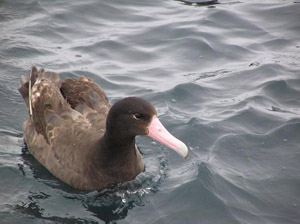Short-tailed Albatross
Common Name: Short-tailed Albatross
Scientific Name: Phoebastria albatrus

Description
With a wingspan of over 2 meters (over7 feet), the short-tailed albatross is the largest seabird in the North Pacific. Itslong, narrow wings are adapted to soaring low over the ocean. It is best distinguished from other albatrosses by its large, bubblegum-pink bill. Young birds also have the large pink bill, but their feathers are dark chocolate brown, gradually turning white as the bird ages. Adults have an entirely white back, white or light gold head and back of neck, and black and white wings.
Range and Population Level
Historically, millions of short-tailed albatrosses bred in the western North Pacific on several islands south of the main islands of Japan. Only two breeding colonies remain active today: Torishima Island and Minami-kojima Island, Japan. In addition, a single nest was recently found on Yomejima Island of the Ogasawara Island group in Japan. Single nests also occasionally occur on Midway Island, HI. Short-tailed albatrosses forage widely across the temperate and subarctic North Pacific, and can be seen in the Gulf of Alaska, along the Aleutian Islands, and in the Bering Sea. The world population is currently estimated to be about 1200 birds and is increasing.
Habitat and Habits
Like many seabirds, short-tailed albatrosses are slow to reproduce and are long-lived, with some known to be over 40 years old. They begin breeding at about 7 or 8 years, and mate for life. Short-tailed albatrosses nest on sloping grassy terraces on two rugged, isolated, windswept islands in Japan. Pairs lay a single egg each year in October or November. Eggs hatch in late December through early January. Chicks remain near the nest for about 5 months, fledging in June. After breeding, short-tailed albatrosses move to feeding areas in the North Pacific. When feeding, albatrosses alight on the ocean surface and seize their prey, including squid, fish, and shrimp.
 Deep Sea Crabs
Deep Sea Crabs